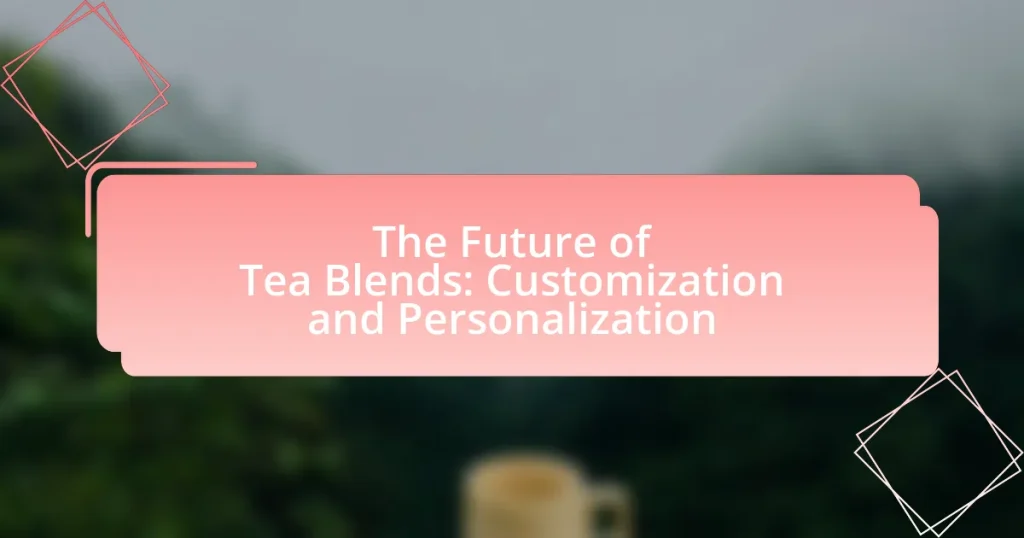The article focuses on the future of tea blends, emphasizing the growing trend of customization and personalization driven by consumer demand for unique flavors and health benefits. It highlights how technology, including AI and data analytics, is enabling tea brands to create tailored blends that cater to individual preferences. Key factors influencing this shift include consumer preferences for personalized experiences, health trends, and advancements in blending techniques. The article also discusses the logistical challenges of producing customized blends, the role of apps and online platforms in facilitating personalization, and the emerging flavors and ingredients shaping the market. Overall, it underscores the importance of personalization in enhancing customer satisfaction and loyalty within the tea industry.

What is the Future of Tea Blends: Customization and Personalization?
The future of tea blends is increasingly focused on customization and personalization, driven by consumer demand for unique flavor profiles and health benefits. As consumers seek tailored experiences, tea brands are leveraging technology, such as AI and data analytics, to create personalized blends that cater to individual preferences. Research indicates that 70% of consumers are interested in personalized products, highlighting a significant market trend towards customization in the beverage industry. This shift is further supported by the rise of subscription services that allow consumers to select and receive customized tea blends based on their tastes and health goals.
How is customization changing the tea blending industry?
Customization is transforming the tea blending industry by enabling consumers to create personalized blends that cater to their individual tastes and health preferences. This shift is driven by advancements in technology, such as online platforms and mobile applications, which allow users to select specific ingredients, flavors, and health benefits, resulting in a more engaging and tailored tea experience. According to a report by Grand View Research, the global tea market is projected to reach $73.3 billion by 2024, with a significant portion attributed to the demand for customized products. This trend reflects a broader consumer desire for unique and personalized food and beverage options, leading tea companies to innovate and diversify their offerings to meet these evolving preferences.
What are the key factors driving customization in tea blends?
The key factors driving customization in tea blends include consumer preferences, health trends, and technological advancements. Consumer preferences are increasingly leaning towards personalized experiences, with surveys indicating that 70% of tea drinkers express interest in unique flavor profiles tailored to their tastes. Health trends also play a significant role, as more individuals seek blends that cater to specific health benefits, such as stress relief or digestive support, reflecting a growing market for functional beverages. Additionally, technological advancements in blending techniques and online platforms enable consumers to create their own blends easily, further fueling the demand for customization in the tea industry.
How do consumer preferences influence tea blend personalization?
Consumer preferences significantly influence tea blend personalization by driving the demand for unique flavors and health benefits. As consumers increasingly seek tailored experiences, tea brands respond by offering customizable blends that cater to individual tastes, such as fruity, floral, or spicy notes. Research indicates that 70% of consumers prefer products that align with their personal preferences, prompting companies to innovate and create blends that reflect these desires. This trend is supported by market data showing a 25% increase in sales for personalized tea products over the past three years, highlighting the direct correlation between consumer preferences and the evolution of tea blend offerings.
Why is personalization important in the tea market?
Personalization is important in the tea market because it enhances customer satisfaction and loyalty by catering to individual preferences. Consumers increasingly seek unique experiences, and personalized tea blends allow them to select flavors, ingredients, and health benefits that align with their specific tastes and needs. According to a study by McKinsey, 71% of consumers expect companies to deliver personalized interactions, which drives brands in the tea market to adopt customization strategies to remain competitive and relevant. This trend not only boosts sales but also fosters a deeper connection between consumers and brands, ultimately leading to increased market share.
What benefits does personalized tea blending offer to consumers?
Personalized tea blending offers consumers the benefit of tailored flavor profiles that cater to individual preferences and health needs. This customization allows consumers to select specific ingredients that align with their taste, dietary restrictions, or wellness goals, such as stress relief or energy enhancement. Research indicates that personalized products can lead to higher consumer satisfaction and loyalty, as individuals feel a greater connection to products that reflect their unique identities and preferences.
How does personalization enhance the overall tea experience?
Personalization enhances the overall tea experience by allowing consumers to tailor flavors, aromas, and health benefits to their individual preferences. This customization leads to increased satisfaction, as studies show that personalized products can improve consumer engagement and loyalty. For instance, a survey by the National Tea Association found that 70% of tea drinkers prefer blends that cater to their specific tastes and dietary needs, demonstrating that personalization directly correlates with a more enjoyable and meaningful tea experience.

What trends are shaping the future of tea blends?
The future of tea blends is being shaped by trends in customization and personalization. Consumers increasingly seek unique flavor profiles and health benefits tailored to their individual preferences, leading to a rise in bespoke tea blends. According to a report by Grand View Research, the global herbal tea market is expected to reach $4.5 billion by 2025, driven by consumer demand for personalized health solutions. Additionally, advancements in technology, such as mobile apps for tea selection and subscription services, facilitate personalized experiences, allowing consumers to curate their own blends based on taste, aroma, and health benefits.
How are technology and innovation impacting tea blend customization?
Technology and innovation are significantly enhancing tea blend customization by enabling precise flavor profiling and personalized recommendations. Advanced data analytics and artificial intelligence allow companies to analyze consumer preferences and create tailored blends that cater to individual tastes. For instance, companies like Tea Forté utilize machine learning algorithms to suggest blends based on user feedback and purchase history, resulting in a more personalized tea experience. Additionally, innovations in extraction and flavoring techniques, such as cold brewing and natural flavor infusions, provide consumers with unique and customizable options that were previously unavailable. These advancements not only improve customer satisfaction but also drive market growth, as evidenced by the increasing demand for personalized food and beverage products, projected to reach $50 billion by 2025 according to a report by Allied Market Research.
What role do apps and online platforms play in personalized tea selection?
Apps and online platforms play a crucial role in personalized tea selection by utilizing algorithms and user data to recommend blends tailored to individual preferences. These digital tools analyze factors such as flavor profiles, caffeine levels, and health benefits, allowing users to discover teas that align with their tastes and needs. For instance, platforms like TeaVivre and Adagio Teas offer quizzes and personalized recommendations based on user input, enhancing the selection process. This data-driven approach not only improves user satisfaction but also fosters a deeper connection between consumers and their tea choices, as evidenced by the growing trend of customized tea subscriptions that cater to specific preferences.
How is data analytics used to tailor tea blends to individual tastes?
Data analytics is utilized to tailor tea blends to individual tastes by analyzing consumer preferences, purchase history, and sensory data. Companies collect data from customer feedback, surveys, and social media interactions to identify flavor profiles that resonate with specific demographics. For instance, a study by the International Journal of Food Science found that 70% of consumers prefer personalized products, indicating a strong market demand for customized tea blends. By leveraging machine learning algorithms, businesses can predict trends and create blends that align with individual taste preferences, enhancing customer satisfaction and loyalty.
What are the emerging flavors and ingredients in customized tea blends?
Emerging flavors and ingredients in customized tea blends include adaptogenic herbs, floral notes, and exotic spices. Adaptogens like ashwagandha and reishi mushroom are increasingly popular for their stress-relief properties, while floral ingredients such as hibiscus and lavender add unique aromas and health benefits. Exotic spices like turmeric and cardamom are also gaining traction for their anti-inflammatory properties and flavor complexity. According to a report by Grand View Research, the global herbal tea market is expected to grow significantly, indicating a rising consumer interest in these innovative ingredients.
Which unique ingredients are gaining popularity in tea blends?
Unique ingredients gaining popularity in tea blends include adaptogenic herbs like ashwagandha and reishi mushrooms, as well as botanicals such as hibiscus and butterfly pea flower. These ingredients are increasingly favored for their health benefits and vibrant colors, appealing to consumers seeking both wellness and aesthetic experiences in their tea. The rise of wellness culture and the demand for functional beverages have driven this trend, with studies indicating that adaptogens can help reduce stress and improve overall health, thus validating their inclusion in modern tea blends.
How do cultural influences shape new tea blend creations?
Cultural influences shape new tea blend creations by integrating traditional flavors, preparation methods, and consumption rituals from diverse societies. For instance, the incorporation of spices like cardamom and ginger in chai blends reflects Indian culinary traditions, while the use of floral notes in Japanese teas highlights the cultural significance of aesthetics and nature. Additionally, globalization allows for cross-cultural experimentation, leading to innovative blends that combine elements from various tea-drinking cultures, such as the fusion of matcha with Western ingredients like chocolate. This blending of cultural practices not only enhances flavor profiles but also creates unique consumer experiences that resonate with diverse audiences.

What challenges exist in the customization and personalization of tea blends?
The challenges in the customization and personalization of tea blends include sourcing high-quality ingredients, ensuring flavor consistency, and managing consumer preferences. Sourcing high-quality ingredients can be difficult due to variability in crop yields and availability, which affects the overall quality of the final product. Ensuring flavor consistency is challenging because natural ingredients can vary in taste and potency based on factors such as harvest time and processing methods. Additionally, managing consumer preferences is complex, as individual tastes can differ widely, making it hard to create blends that satisfy a broad audience while still allowing for personal customization.
What are the logistical challenges of producing customized tea blends?
Producing customized tea blends presents several logistical challenges, including sourcing diverse ingredients, managing inventory, and ensuring quality control. Sourcing requires establishing relationships with multiple suppliers to obtain various tea leaves and flavoring agents, which can complicate procurement processes. Managing inventory becomes challenging due to the need to stock a wide range of ingredients in varying quantities, leading to potential overstock or shortages. Quality control is critical, as maintaining consistent flavor profiles and freshness across different batches necessitates rigorous testing and monitoring. These challenges are compounded by the need for efficient distribution systems to deliver customized products to consumers promptly.
How do suppliers manage the demand for personalized tea products?
Suppliers manage the demand for personalized tea products by utilizing data analytics and customer feedback to tailor their offerings. They analyze purchasing patterns and preferences to create customized blends that meet specific consumer desires. For instance, suppliers often employ surveys and social media insights to gather information on flavor preferences and health benefits sought by customers. This data-driven approach allows suppliers to adjust inventory and production schedules accordingly, ensuring they can meet the fluctuating demand for personalized options. Additionally, suppliers may implement flexible manufacturing processes that enable quick adjustments to product lines based on real-time demand signals, enhancing their responsiveness to market trends.
What quality control measures are necessary for customized blends?
Quality control measures necessary for customized blends include ingredient sourcing, blending consistency, sensory evaluation, and batch testing. Ingredient sourcing ensures that high-quality raw materials are selected, which directly impacts the final product’s flavor and aroma. Blending consistency involves precise measurements and mixing techniques to maintain uniformity across batches, ensuring that each blend meets the established flavor profile. Sensory evaluation, conducted by trained panels, assesses the taste, aroma, and appearance of the blends to ensure they align with consumer expectations. Batch testing, including chemical and microbiological analysis, verifies that the blends meet safety and quality standards, confirming that they are free from contaminants and meet regulatory requirements. These measures collectively ensure that customized tea blends are safe, consistent, and of high quality.
How can businesses effectively implement customization strategies?
Businesses can effectively implement customization strategies by leveraging data analytics to understand customer preferences and tailoring products accordingly. By analyzing purchasing behavior and feedback, companies can create personalized tea blends that cater to individual tastes, enhancing customer satisfaction. For instance, a study by McKinsey & Company found that personalization can lead to a 10-30% increase in revenue, demonstrating the financial benefits of customization. Additionally, utilizing technology such as AI-driven recommendation systems can streamline the customization process, allowing businesses to efficiently offer unique blends that resonate with their target audience.
What best practices should tea companies follow for personalization?
Tea companies should implement data-driven customer segmentation to enhance personalization. By analyzing customer preferences, purchase history, and feedback, companies can tailor their offerings to meet individual tastes. For instance, a study by McKinsey & Company found that personalized marketing can lead to a 10-30% increase in revenue. Additionally, utilizing technology such as AI and machine learning can help in predicting customer preferences and recommending products accordingly. Engaging customers through personalized communication, such as targeted emails and loyalty programs, further strengthens the relationship and encourages repeat purchases.
How can customer feedback be integrated into tea blend development?
Customer feedback can be integrated into tea blend development by systematically collecting and analyzing consumer preferences and suggestions. This process involves utilizing surveys, focus groups, and social media interactions to gather insights on flavor profiles, ingredients, and overall satisfaction. For instance, companies like Tetley and Twinings have successfully implemented customer feedback mechanisms, leading to the creation of blends that resonate with consumer tastes, thereby increasing sales and customer loyalty. By continuously refining blends based on this feedback, tea brands can ensure their products align with market demands and enhance customer experience.
What practical tips can consumers use to explore personalized tea blends?
Consumers can explore personalized tea blends by experimenting with different tea bases, such as black, green, or herbal, and adding various flavoring ingredients like fruits, spices, and herbs. This hands-on approach allows individuals to discover unique combinations that suit their taste preferences. For instance, blending chamomile with lavender can create a soothing herbal mix, while combining green tea with citrus peels can yield a refreshing flavor profile. Additionally, consumers can utilize online platforms and apps that offer customization tools, enabling them to select ingredients based on flavor, health benefits, or aroma, thus enhancing their tea experience.


